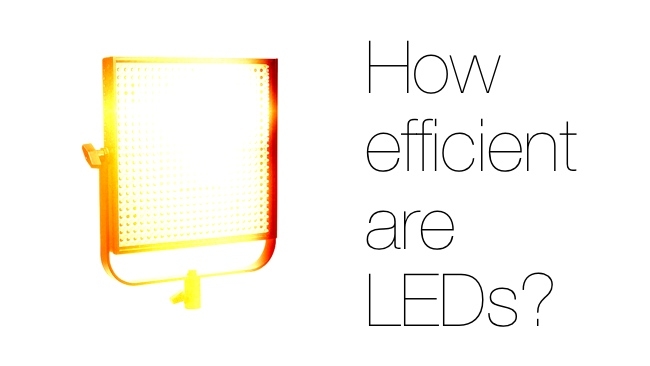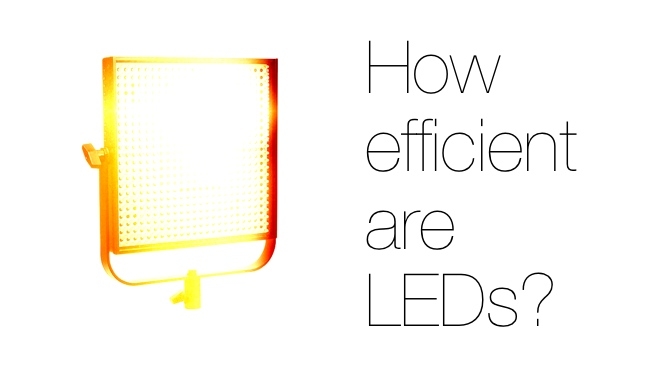
 How efficient are LEDs
How efficient are LEDs
Some LED manufacturers are making claims about efficiency that just don't make sense, says Phil Rhodes
We've done quite a bit of analysis on new LED lighting technology in the past. I've touched claims of accurate colour rendering based on the ageing CRI measurement that is hopelessly inadequate to assess the problems typical of LEDs, and the newer, more capable TLCI standard. We've also discussed the efficiency issues, comparing the output of real-world LED, HMI and fluorescent lighting, and compared LEDs, which are at best ten or twenty per cent more efficient, on a cost basis. But now it looks like there's something else to watch out for. Recently, I met one prominent manufacturer of LED lights, whose blushes I will spare, who claimed that their unit has an output equivalent to 1000W of tungsten. This, they claimed, came from a light that I discovered – after asking several times and receiving what felt like a bit of evasion – consumed 40W of power.
This is patently absurd.
Now, let's get one thing straight: LED is a lot more efficient than tungsten, possibly four or five times more efficient. One of the reasons you might want to buy LED over cheaper-for-the-same-light HMI is that it's dimmable and that LED is considerably more efficient if you want hard tungsten-balanced light than any other technology. But it is very certainly not twenty-five times more efficient, as the 40W = 1000W claim would require.
What's going on here?
Let's figure out what's really going on here. In their literature, many manufacturers of LED lighting mention the LUMEN Coalition, named after the cute US-centric acronym “Lighting Understanding for a More Efficient Nation.” The key information that the LED manufacturers claim to be using from LUMEN is that the efficiency of an incandescent light is 16 lumens per watt, and that this radiation pattern is understood to be emitted into 360 degrees. This is indeed a reasonable set of numbers for a domestic tungsten incandescent bulb in the 60 to 100W range.
The problem is that this has next to nothing to do with movie lighting. LUMEN is a group of LED manufacturers, retailers and government bodies set up to counter the sometimes rather eyebrow-raising diatribe of some folks who object vocally to the fact that they're being encouraged to buy something other than the least efficient means possible of producing light in their homes. Its goals are laudable and its facts straight, as near as I can tell from glancing through its website, but none of this has anything even remotely to do with a high powered quartz halogen bulb in a collimating assembly of both reflector and lens in something like an Arri 1K fresnel.
Light in one direction
Not only are quartz halogen bulbs considerably more efficient in themselves (around 24lm/W, over the 16 of a household lightbulb), but the entire calculation is thrown hopelessly out by the fact that a normal tungsten halogen lighting device intended for film and TV work has a reflector and a lens which is specifically designed to throw as much of the light as possible in a useful direction. Likewise, LED lighting invariably involves either fresnel lenses that work in a very similar way to the tungsten version, or LED arrays with individual collimating optics on each device. LUMEN's numbers – which are being used by the LED manufacturers – assume a spherical radiation pattern.
So what's actually going on here is that some LED manufacturers are massively inflating their performance-equivalence figures by comparing their products with something that doesn't exist (a thousand-watt household lightbulb) applied in a way that would never normally be used (a bare lightbulb, notwithstanding Mole's product) and which isn't collimated. When most people hear the words “a 1K tungsten” in the context of film and TV, they will think of a tungsten quartz halogen fresnel, not a non-existent, non-halogen, non-collimated 1000W household bulb on a stick.
Guide to LED Power
And so that Red Shark readers may be more fully nonsense-proofed, here's Phil's Guide to Equivalent LED Power: get the actual power consumed by the device and multiply by four, four and a half if you're feeling particularly generous and have a lot of trust in the company in question. A 40W LED light should be a bit more powerful, then, than a 150 watt tungsten fresnel, give or take the factor of how wide or narrow a beam it emits. Now, this advice will date quickly, as this is a hot research topic with a lot of gold available to researchers who achieve significant improvements in LED efficiency, but I suspect it'll be quite some time before any LED really has a luminous efficacy of 400 lumens per watt. I mean, the absolute theoretical limit is only 555.
Ultimately this hurts everyone, because it effectively causes LED lighting, which is genuinely good and worthwhile and offers significant efficiency savings, to write cheques it can't cash. I have no wish to see the reputation of the technology stained by this sort of thing, and I don't think it's necessary to do this for it to be an attractive financial proposition. I have no doubt that this sort of behaviour will be widely defended as the normal cut and thrust of advertising and public relations. The problem is that if someone actually buys one of these things and takes it to set to replace a real 1K, it will, regardless of anyone's politics, fail to adequately do so.
Tags: Technology


Comments